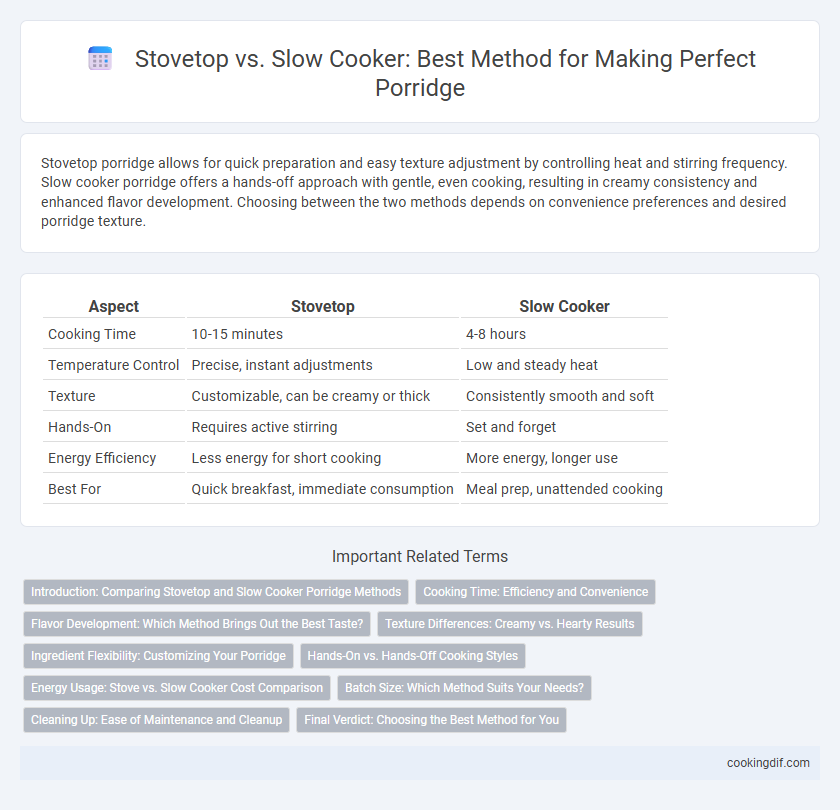Stovetop porridge allows for quick preparation and easy texture adjustment by controlling heat and stirring frequency. Slow cooker porridge offers a hands-off approach with gentle, even cooking, resulting in creamy consistency and enhanced flavor development. Choosing between the two methods depends on convenience preferences and desired porridge texture.
Table of Comparison
| Aspect | Stovetop | Slow Cooker |
|---|---|---|
| Cooking Time | 10-15 minutes | 4-8 hours |
| Temperature Control | Precise, instant adjustments | Low and steady heat |
| Texture | Customizable, can be creamy or thick | Consistently smooth and soft |
| Hands-On | Requires active stirring | Set and forget |
| Energy Efficiency | Less energy for short cooking | More energy, longer use |
| Best For | Quick breakfast, immediate consumption | Meal prep, unattended cooking |
Introduction: Comparing Stovetop and Slow Cooker Porridge Methods
Stovetop porridge offers quick preparation with precise temperature control, allowing for a creamy texture through constant stirring. Slow cooker porridge requires minimal supervision, using low heat over several hours to naturally break down grains for a smooth, hearty consistency. Choosing between methods depends on time availability and desired texture, with stovetop suiting immediate meals and slow cooker ideal for overnight cooking.
Cooking Time: Efficiency and Convenience
Stovetop porridge typically cooks within 5 to 10 minutes, offering rapid preparation ideal for busy mornings. Slow cookers require 6 to 8 hours, providing convenience through overnight cooking with minimal supervision. Efficiency depends on lifestyle; stovetop suits quick meals, while slow cookers enhance ease and hands-off preparation.
Flavor Development: Which Method Brings Out the Best Taste?
Stovetop porridge allows precise temperature control, promoting Maillard reactions that enhance nutty, caramelized flavors. Slow cooker porridge develops a deeper, more mellow taste through prolonged simmering, which softens grains and evenly infuses sweetness. Flavor intensity varies with cooking duration, but stovetop methods often achieve a richer, more complex profile due to higher heat exposure.
Texture Differences: Creamy vs. Hearty Results
Stovetop porridge yields a creamy texture achieved by constant stirring and controlled heat, which breaks down oats more thoroughly. Slow cooker porridge develops a hearty, thicker consistency due to long, low-temperature cooking that preserves some oat grain structure. Choosing between methods depends on desired mouthfeel: stovetop offers smooth creaminess, while slow cooker delivers robust, chewy results.
Ingredient Flexibility: Customizing Your Porridge
Stovetop porridge allows immediate ingredient adjustments, enabling precise control over texture and flavor during cooking, perfect for adding nuts, fruits, or spices at specific stages. Slow cookers offer a hands-off approach but require pre-planned ingredient combinations to avoid overcooking delicate additions like berries or seeds. Selecting stovetop or slow cooker methods depends on your preference for real-time customization versus convenience in preparing diverse porridge variations.
Hands-On vs. Hands-Off Cooking Styles
Stovetop porridge requires active stirring and close attention to prevent burning, offering a hands-on cooking experience that allows for precise texture control. Slow cooker porridge provides a hands-off method, where ingredients can be combined and left to cook slowly over several hours, ideal for busy schedules requiring minimal supervision. Choosing between stovetop and slow cooker depends on preference for direct involvement versus convenience and time flexibility.
Energy Usage: Stove vs. Slow Cooker Cost Comparison
Cooking porridge on a stovetop typically uses more energy due to higher heat settings and shorter cooking times, whereas slow cookers operate on low wattage over extended periods, resulting in lower overall energy consumption. Slow cookers consume approximately 75 to 150 watts per hour compared to an electric stove's 1500 to 3000 watts during active heating. Cost analysis reveals slow cookers may reduce electricity bills when preparing porridge, especially for longer cooking durations or overnight recipes.
Batch Size: Which Method Suits Your Needs?
Stovetop porridge preparation allows for precise control over smaller batch sizes, making it ideal for quick servings and immediate consumption. Slow cookers excel at handling larger volumes with minimal supervision, perfect for batch cooking and meal prep across multiple days. Choosing between stovetop and slow cooker depends on your porridge quantity requirements and desired hands-off cooking convenience.
Cleaning Up: Ease of Maintenance and Cleanup
Stovetop porridge requires immediate cleaning to prevent residue from hardening on the pot, making maintenance more labor-intensive. Slow cookers often feature removable, non-stick inserts that simplify cleanup by allowing easy soaking and washing. Choosing a slow cooker minimizes scrubbing time and enhances convenience for regular porridge preparation.
Final Verdict: Choosing the Best Method for You
Stovetop porridge offers quicker cooking times and precise control over texture, ideal for those who prefer a creamy consistency in under 15 minutes. Slow cooker porridge requires minimal supervision and provides a rich, evenly cooked result with a thicker texture ideal for busy mornings or meal prepping. Selecting the best method depends on your schedule and texture preference, with stovetop favored for speed and customization, while slow cooker excels in convenience and hands-off cooking.
Stovetop vs slow cooker for method Infographic

 cookingdif.com
cookingdif.com